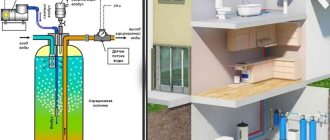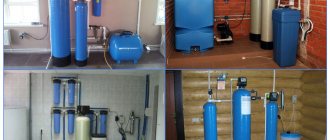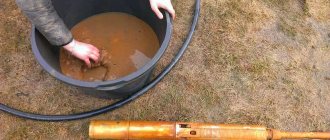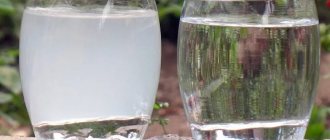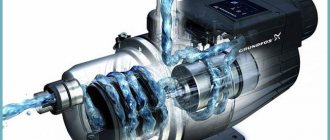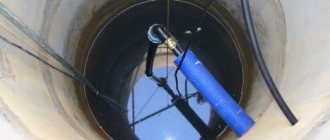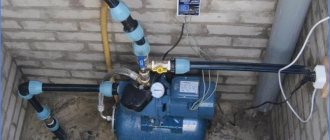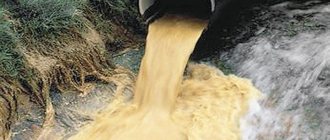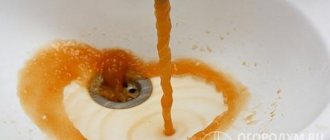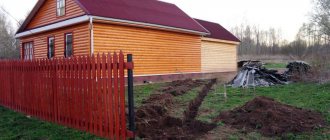Borehole water supply, widely used in the autonomous water supply of a private home to obtain drinking water in the absence of a centralized water main, has one significant drawback - the water environment at the source is not always clean. Some owners sometimes have to solve the following problem on their own: the water from the well smells of hydrogen sulfide, what to do.
To cope with such a situation, it is useful to know the causes and process of water poisoning with hydrogen sulfide gas. This will help you choose the right effective technology and water treatment equipment.
Rice. 1 Water with H2S
Why does water from a well, boiler, well or pipe smell like hydrogen sulfide?
Water from a well, boiler, well or pipes may suddenly begin to smell of hydrogen sulfide. The smell is identical to that of "rotten eggs". The reason for the smell of hydrogen sulfide is the proliferation of bacteria in the water. Water from the city water supply is usually specially prepared, highly disinfected, chlorinated, and such cases rarely occur with it.
Large amounts of hydrogen sulfide gas (H2S) are released and accumulated as a result of the activity of sulfate-reducing (sulfate-reducing) bacteria in water.
Sulfate-reducing bacteria (SRB) use organic matter (CH2O) or hydrogen (H) as an electron donor and sulfate (SO4) as an electron acceptor to produce energy
2CH2O + SO42- + 2H+ => 2CO2 + H2S + 2H2O
Simply put, there are two types of sulfate-reducing bacteria. Both varieties require sulfates - sulfur compounds - as well as hydrogen to survive. But one species of bacteria extracts hydrogen from organic matter in the sludge . Other bacteria use molecular hydrogen , which is found in water.
IMPORTANT ! The development of sulfate-reducing bacteria occurs under anaerobic conditions , in the absence of free oxygen in water.
Sulfates are salts of sulfuric acid H2SO4. For example, potassium sulfate K2SO4, sodium hydrogen sulfate NaHSO4. Sulfates are widespread in nature, forming a whole group of minerals. Many sulfates are soluble in water and are found in natural water.
Is it possible to use musty liquid to water the garden?
It often contains large amounts of iron or hydrogen sulfide and can negatively affect crop yields. For example, cucumbers, currants, tomatoes, peaches, cherries, pears, apricots, and apple trees are the most vulnerable.
However, the environment around us has a unique property of self-purification. Moreover, plants are not always able to absorb this or that harmful substance. For example, rainwater contains a large amount of iron. Due to the reaction with oxygen, plants do not have time to absorb it, and iron is quickly removed from the soluble phase. The same goes for hydrogen sulfide gas.
Important! Regular watering can lead to negative results. Watering the garden with musty, swampy water once is not harmful to the plants.
Why is hydrogen sulfide dangerous?
Hydrogen sulfide (H2S) is poorly soluble in water. Flammable. The concentration limits of ignition in a mixture with air are 4.5-45% hydrogen sulfide.
Hydrogen sulfide is very toxic. Inhaling air with a small content of hydrogen sulfide causes dizziness, headache, nausea, and with a significant concentration it leads to coma, convulsions, pulmonary edema and even death. At high concentrations, a single inhalation can cause instant death . When inhaling air with small concentrations, a person quickly adapts to the unpleasant smell of “rotten eggs” and it ceases to be felt. A sweetish metallic taste appears in the mouth.
When inhaling air with a high concentration due to paralysis of the olfactory nerve, the smell of hydrogen sulfide almost immediately ceases to be felt. Hydrogen sulfide is also used for medicinal purposes, in hydrogen sulfide baths.
The appearance of hydrogen sulfide in water is not only an unpleasant odor and a health hazard. A solution of hydrogen sulfide in water is a very weak hydrogen sulfide acid. Hydrogen sulfide turns water into an acid , albeit a very weak one.
Increasing the acidity of water, for example, accelerates electrochemical corrosion of metals in plumbing and plumbing equipment.
Sorption methods
Sorption filters for purifying water from hydrogen sulfide are the most popular due to their ease of use. Inside such filters there is a cartridge with a special sorption material, which promotes the active oxidation of H2S molecules, absorbs harmful substances and carries out fine cleaning. The most popular coal is Centaur® , which is produced from coal rocks.
Equipment for sorption purification is quite compact and does not require large investments. However, this technology also has its drawback - at high concentrations of hydrogen sulfide, it will not be possible to remove all the gas. The method is effective if the concentration of hydrogen sulfide is no more than 3 mg/l. If the concentration is higher, then this method can be effectively used in combination with aeration.
Three sources of hydrogen sulfide in water
Bacteria in sludge cause hydrogen sulfide odor
The nutrient medium for some varieties of sulfate-reducing bacteria is sludge, which contains organic compounds. Such bacteria are present in nature, for example, in silt deposits at the bottom of swamps and lakes. Or in artificial structures - in a sewer septic tank, for example. Either at the bottom of the well, or in the well, if organic contaminants accumulate there.
At the bottom of the well, in the aquifer lens of the well, in the storage tank or in the boiler tank, over time, a layer of silt settles and accumulates from the water, which can become a habitat for sulfate-reducing bacteria.
Water from a well or well is often supplied to the house by pump. In this case, an autonomous water supply system usually has a non-pressure storage tank or a membrane accumulator, as well as other vessels - filters, for example. In all these vessels, sludge accumulates, in which SRB can settle. The cause of the smell of hydrogen sulfide in water flowing from taps may not be a well or well, but rather vessels in the water supply system of the house.
Bacteria in water is another cause of odor.
Other species of SRB live in water. To survive, such bacteria require molecular hydrogen . This type of bacteria can also be found in natural water. Some of them live in natural thermal water sources at a temperature of +110 °C.
The influx of hydrogen sulfide water from outside is the third cause of the smell
Water containing hydrogen sulfide may flow into a well or borehole from outside. The saturation of water with hydrogen sulfide occurs somewhere else. For example, bacteria live in an abandoned well on a neighboring property. And water from there comes into your well, already saturated with harmful gas.
In order to get rid of the smell of hydrogen sulfide, the most effective way is to eliminate the cause - to eliminate the conditions for the life and reproduction of sulfate-reducing bacteria.
In a well, well, or water tank, sulfate-reducing bacteria may be present in both sludge and water at the same time. But usually, one type of bacteria is the most active. Depending on what type of SRP is the cause of the hydrogen sulfide smell, the method of getting rid of bacteria is chosen.
In some cases, it is not possible or too expensive to get to the place of residence of the SLO and deprive them of their lives there. For example, bacteria live in the water intake lens of a well. And from there comes water already saturated with harmful gas. Reworking a well is expensive. In this case, you have to fight not bacteria, but use methods to neutralize the gas dissolved in water.
Filtration from hydrogen sulphide
If you live in a private cottage or have a country house in a village where there is no central water supply, or maybe you just prefer to do your own water treatment in order to be completely confident in the naturalness and high quality of the resource, then you probably use a well as a source. This is the same option preferred by many commercial enterprises, since purchasing the resource is more expensive and involves more potential problems than producing it yourself. Unfortunately, it is not enough to simply drill a hole and install pumping equipment; it is necessary to equip a filtration system, and hydrogen sulfide becomes one of the “enemies” of high-quality water treatment. Let's figure out where it comes from and why it needs to be removed.
How to remove the smell of hydrogen sulfide from hot water boiler
In the boiler tank, over time, a layer of sludge settles from the water and accumulates at the bottom, which can become a habitat for sulfate-reducing bacteria.
But most often, the reason for the appearance of hydrogen sulfide in the boiler is the proliferation of SRP in the boiler water.
The fact is that molecular hydrogen is released especially intensively in the water heater tank if the protective corrosion protection operates in the “overprotection” mode.
If the water in the water heater tank contains a sufficiently large amount of sulfates, and the protective protection operates in the “overprotection” mode, with intense hydrogen release, then conditions are created for the active proliferation of sulfate-reducing bacteria in the water.
Determining the cause is not difficult - remove the sacrificial anode from the tank and turn on the water heater without the anode. If the water no longer smells like rotten eggs, the reason has been found.
Elimination of bacteria that live in the boiler in the sludge layer
It may be enough to do at least one of the following:
- The easiest way is to raise the water temperature above 70 °C and use this water for three days until the smell disappears. In the future, constantly keep the water temperature in the boiler above 55 ° C. It is recommended to periodically increase the temperature above 70 °C.
- Regularly clean the boiler to remove scale and sludge deposits on the bottom.
- Take measures to reduce the amount of organic contaminants in tap water that enters the boiler. To do this, you can change the water intake horizon - instead of a well, take water from a well. Install filters to purify tap water from mechanical and organic contaminants.
Eliminating bacteria from boiler water
To suppress sulfate-reducing bacteria living in boiler water, it is often enough to do the following:
- Try raising the water temperature above 70 °C and using this water for three days until the smell disappears. In the future, constantly keep the water temperature in the boiler above 55 ° C. It is recommended to periodically increase the temperature above 70 °C. But this method does not always help. Bacteria living in boiler water are often resistant to these temperatures.
- The activity of sulfate-reducing bacteria is suppressed if the molecular hydrogen content in water is reduced. For this purpose, the operating mode of the tread protection is optimized. Replacing a magnesium anode with an aluminum one reduces the hydrogen content in water , as it eliminates “overprotection”.
For information on replacing anodes, read: “Magnesium or aluminum anode for a water heater.”
General measures to combat bacteria in the boiler
The following measures can suppress the development of bacteria in both water and sludge:
- Aeration, air saturation, of tap water supplied to the boiler leads to an increase in the content of free oxygen in the water. As a result, the anaerobic habitat of bacteria changes to one less favorable for their life.
- Disinfect tap water using methods whose antibacterial effect persists for a long time after treatment - chlorination, etc. Ultraviolet water treatment is not suitable for this.
- Take measures to reduce the amount of soluble sulfur compounds in tap water. To do this, you can change the water intake horizon - instead of a well, take water from a well or deepen the well. These measures should be selected after testing the water source for sulfate content.
Hydrogen sulfide in a well most often appears as a result of the activity of bacteria, the nutrient medium of which is the organic substances in the sludge at the bottom and on the walls of the well shaft.
First of all, it is necessary to take measures to reduce the amount of organic contaminants in well water. These contaminants usually enter the water from the surface of the earth.
Such measures include the following:
- Do not leave the well open;
- Maintain a distance of at least 20 meters from the well to the sewerage system;
- Reliably seal the walls of the well from the penetration of water from the surface of the earth and the perched water;
- Use submersible pumps with remote injectors, this significantly reduces the number of leaks;
- Carry out regular preventive maintenance by disinfecting the well shaft with chemicals, cleaning the well from silt deposits, and replacing the filter stone backfill at the bottom.
However, these measures may not be enough. I recommend doing one of the following two things:
Aeration, saturation with air, of water directly in the well leads to an increase in the content of free oxygen in the water. As a result, the anaerobic habitat of sulfate-reducing bacteria changes to one less favorable for their life.
In addition, aeration reduces the content of iron and manganese compounds dissolved in water. The process of deferrization of water occurs. As a result of the saturation of well water with oxygen, the divalent iron dissolved in the water is oxidized to the ferric hydroxide form in the form of solid particles suspended in the water. The particles slowly fall out into a red-brown precipitate. Or they are extracted with water by a pump and retained by a fine-pored filter.
In the same way, during aeration, by oxidation to insoluble sulfur, hydrogen sulfide, which entered the well with water from the outside, is removed from the aquifer.
Kit for aerating water in a well: membrane compressor, aerator with a capacity of 20-60 l/min, tubular aerators, distribution comb
A membrane air compressor aerator supplies air, which is sprayed into fine bubbles through a layer of water in the well. The compressor operates periodically and is controlled by a time relay.
The dispenser with chemicals for the pool is also convenient to use for disinfecting water in the well.
The water directly in the well is continuously disinfected in order to suppress bacteria - chlorinated. To do this, it is convenient to use a special dosing cartridge, inside of which chlorine-containing calcium hypochlorite is placed. The cartridges are made of ceramic and are designed to hold different amounts of disinfectant. To disinfect water, the cartridge is immersed in water. Due to the porosity of the cartridge walls, active chlorine enters the well water. The disinfectant filling in the cartridge is changed as it is used up. The presence of residual chlorine in water is determined qualitatively - by smell or using the iodometric method.
On sale you can find and use dispensers and chemicals for similar purposes to disinfect water with chlorine in swimming pools.
One of the disadvantages of constant chlorination is that the chlorinated water eventually ends up in the sewer septic tank, where the chlorine in the water suppresses the already beneficial bacteria that decompose organic matter in the drain.
Disinfection of mine wells and disinfection of water in them is carried out in accordance with the “Temporary Instructions for the disinfection of mine wells and disinfection of water in them”, approved by the Main Sanitary and Epidemiological Directorate of the USSR Ministry of Health on January 18, 1967 N 663-67.
Causes
Hydrogen sulfide water is formed under the following conditions:
- silting of the bottom and walls of pipes when the source has not been cleaned for a long time
- ingestion of biological objects
- plugged aquifers (typical of deep wells)
- loss of tightness of the casing, which leads to the ingress of sulfite bacteria
- while drilling, a layer with sulfide ores was encountered
- prolonged or heavy rainfall, floods, which saturate aquifers with organic matter and chemicals that serve as food for bacteria
- ingress of sulfur compounds during the source installation process
- technogenic pollution.
How to get rid of hydrogen sulfide in well water
Location of aquifers for water intake for water supply
Drilling a well violates the integrity of the upper layers of soil above the aquifer. It is not always possible to restore their tightness when constructing a well. As a result, water from the surface or high water pollutes the water intake layer with organic substances.
Around the well, in the water intake layer, a small lake is formed, from 2-3 m in diameter to 40-50 m, called a lens.
In the water intake lens around the well, silt accumulates, into which SRB is colonized. This happens especially often if the well has been inactive for some time and there is no water being drawn from it. With constant use of water, organic substances are washed away. and their concentration remains low, insufficient for bacterial growth.
Wells that are drilled “in the sand” and take water from the aquiferous sand layer are more prone to the accumulation of organic contaminants. This is due to the fact that the water in this layer is not very mobile, the productivity of the well is not particularly high - approximately 0.6 m3/hour, and contaminants are not carried away with the flow of water. In addition, the depth of such wells is less than artesian wells, less than 70 m, which facilitates the access of contaminants into the aquifer.
Products for construction and repair
⇆
Ways to eliminate the smell of hydrogen sulfide from a well
Take preventive measures to reduce the amount of organic contaminants entering the aquifer through the wellbore. These measures must apply both when performing work on drilling and constructing a well, and during its operation.
To reduce the risk of water pollution it is necessary:
- The top end of the casing must be permanently closed. Prevent flood or other surface water from entering the casing, which often happens, for example, when a caisson is flooded;
- Maintain a distance of at least 20 meters from the well to sewerage facilities;
- Reliably seal the annulus of the casing pipe from water seepage from the surface of the earth and the perched water;
- Use submersible pumps with remote injectors, this significantly reduces the number of leaks;
Flushing, pumping wells
If the water from the well still begins to smell of hydrogen sulfide, then I recommend trying to rinse and pump the well. Continuously pump water out of the well for a long time - up to several days, until the smell disappears. Accumulated contaminants are washed out of the water intake lens. This especially often helps if the well was not used regularly, for example, at the dacha after the winter season.
Disinfection of a well with chlorine-containing chemicals followed by its flushing
Determine the volume of water in the well. To do this, we measure the height of the water column in the well casing. By calculation, using the known height of the water column and the internal diameter of the casing, we determine the volume of water in the well. For example, a volume of 1 m of pipes with a diameter of 50 mm. is 2 l., 75 mm - 5 l., 100 mm - 8 l., 150 mm - 18 l., 200 mm - 32 l., 250 mm - 50 l.. For example, we obtained a volume of water in the well of 100 l .
We create a two to threefold supply of water. For our example, 200-300 liters. Fill existing containers with water.
We select the concentration of the chlorine-containing chemical that you are going to use for your well water. The fact is that the chlorine content in a chemical can vary. In addition, the water contains some amount of substances that react with the chemical, which reduces the chlorine content in the solution. To do this, take a bucket of water from the well (10 liters) and add 100 g (or a glass) of powder, for example, bleach, mix it and let it stand for 15 minutes to complete dissolution. After this, we check the smell of the water: if there is a strong smell of chlorine, chlorination is considered sufficient; if there is no smell or a very weak smell of chlorine, it is necessary to repeat the introduction of another 100 g of bleach. So we add the next 100 g of bleach until we achieve the result. For example, we got a result of 300 g/10 l. There is no need to be afraid of an overdose. The purpose of the experiment is to achieve an effective concentration of chlorine in water with the minimum possible consumption of chlorine-containing chemicals.
Knowing the volume of water in the well and the concentration of the chlorine-containing chemical, we calculate its required amount: 100 l / 300 g / 10 l = 3000 g of bleach. A measured amount of bleach is poured into a bucket, a little water is added to it and ground into a creamy mass without lumps. Then this mass is diluted by adding water to the edge of the bucket. A bucket of bleach solution is poured into the well.
The water in the well with the poured bleach solution is mixed. To do this, organize water circulation in the well. The well pump is started and the water coming out of the well is sent back.
Similarly, from the prepared water reserves, a solution of bleach is made at the rate of 300 g/10 l. Chlorinated water with a total volume of 200-300 liters is poured into the well , in parts or in buckets. As a result, some amount of chlorinated water will move from the well to the water intake lens, where bacteria can also live.
The well is kept in this condition for at least 24 hours. Then the well is flushed. Continuously pump water from the well until the noticeable smell of hydrogen sulfide and chlorine disappears.
To remove excess chlorine (dechlorination), water is filtered through activated or regular charcoal .
When flushing a well, divert dirty water away from the well, otherwise the pumped water will simply return back to the well. Chlorinated water should not be used in a septic tank. It is better to use a special pump that has a high capacity (slightly less than the well flow rate) and is capable of pumping water mixed with sand and silt.
Instead of bleach, you can use other chlorine-containing chemicals, such as calcium hypochlorite or household bleach.
Flushing and chemical disinfection of a well in most cases eliminates the smell of hydrogen sulfide only for a while , until the next summer season or for one and a half to two years. This is due to the fact that these actions do not eliminate the cause - the accumulation of organic contaminants and their colonization by bacteria.
Instructions for monitoring the disinfection of household and drinking water and the disinfection of water supply facilities with chlorine during centralized and local water supply (Approved by the Chief Sanitary Doctor on November 25, 1967 N 723a-67) (current)
Signs of organic and mechanical pollution
A sign that the water is not pure enough is when it becomes cloudy. If you examine a container with this liquid in the light, you can clearly see particles of silt, sand, and fine debris. Under no circumstances should these substances be present in drinking water. Because of them, it becomes dirty and turns brown. And when the well is not used, the water from it begins to smell unpleasant, reminiscent of the smell of a swamp.
In addition, the walls and bottom may become dirty due to improper and incomplete sealing of rings or connections. Due to the poor condition of the walls, shedding occurs, resulting in the water becoming cloudy. Mechanical water purification helps to cope with this situation.
Aeration of water from a well
It is advantageous to install an open storage tank with aeration of water from a well in the attic, under the roof.
In a private home, water aeration is simpler and cheaper without pressure. In a non-pressure system, an open storage tank with aeration of water from a well is installed in the attic of the house. Water is supplied to the tank by a well pump, and is collected by gravity.
An open storage tank can also be installed below, in a pit, well caisson or other room. But then, to supply water from the tank to the house, you will have to install another pump.
A non-pressure water aeration station is used to remove iron, manganese and hydrogen sulfide from water. Effectively removes hydrogen sulfide at a concentration in water of up to 2 mg/l.
To remove hydrogen sulfide in the aerator tank, a water sprayer is installed at the inlet pipe. As water drops fall, they mix with atmospheric air, and gases are partially removed (blown off) from the water: hydrogen sulfide, methane, carbon dioxide, etc.
The compressor supplies air to the aerator at the bottom of the tank. As a result, the water in the tank is saturated with oxygen. Hydrogen sulfide is oxidized to insoluble sulfur and the water is finally cleared of hydrogen sulfide.
Aeration, the saturation of water with air directly in the storage tank, leads to an increase in the content of free oxygen in the water. As a result, the anaerobic habitat of sulfate-reducing bacteria changes to one less favorable for their life.
Aeration also reduces the content of iron and manganese compounds dissolved in water. The process of deferrization of water occurs. As a result of saturation of water with oxygen, divalent iron dissolved in water is oxidized to the trivalent form of iron hydroxide in the form of solid particles suspended in water. The particles slowly fall out into a red-brown precipitate.
If there is a high content of organic contaminants in the water from the well, additional reagents, for example, sodium hypochlorite, are added to the gravity aeration tank.
When installing aeration in a storage tank with your own hands, you can use equipment similar to aerating water in a well (see above).
At the outlet of water from the storage tank, it is recommended to install fine-porous filters that trap solid particles of sulfur and other chemical compounds that are insoluble in water.
A non-pressure aeration station for water from a well for a private house is equipped with all the necessary equipment at the factory
Products for aerating water from a well or well
aerators for fountains and ponds
⇆
A non-pressure water aeration station has the following advantages:
- Thanks to the use of sufficiently large containers in the design (300-1000 l), a long time of interaction of water with oxygen is ensured, compared to other methods of water aeration. This guarantees the most efficient oxidation of iron and hydrogen sulfide. The hydrogen sulfide that entered the tank from the well with water is completely removed from the aquifer.
- A large supply of water constantly existing in the aeration tank eliminates the lack of pressure in the house in case of interruptions in the operation of the well.
- The pump in the well is not required to create high water pressure.
- If necessary, a non-pressure aeration station allows dosing of a disinfecting reagent into the body of the storage tank (dosing of sodium hypochlorite, potassium permanganate, etc.)
This method is not without its drawbacks. The main disadvantage is the bulkiness of the equipment, the need to purchase an air compressor, and also the energy intensity of the entire system.
More reasons for the smell of hydrogen sulfide, as reported by readers:
Recently, one of our clients contacted us because of the presence of a characteristic odor from the water, which was not there before. It had a 500 liter hydraulic accumulator. So, until the membrane in the accumulator tank was changed, the smell did not disappear. We replaced the membrane and the smell disappeared, everything returned to normal. There was a large deposit inside the membrane...
It’s even more trivial - the air pressure in the accumulator has been at zero for a long time. Naturally, the water there is not renewed and, accordingly, fades away. It is easy to treat - the pressure is restored to 1.5 - 2.0 atm, then the hydraulic accumulator is washed by repeatedly adding and releasing water.
More articles on this topic:
⇒ Hot water supply for a private country house ⇒ Either cold or hot water comes from the boiler ⇒ Solar collector - water heater for a house, swimming pool
More articles on this topic
- How to properly insulate an attic
- Liquid thermal insulation as home insulation is a hoax
- Sound insulation - sound insulation of a house, apartment
- Installing a boiler in a private house in the attic
- Concrete floor on the ground in a stone private house
- How to reduce the high gas consumption of a boiler for heating a house
- Cleaning the heat exchanger of a gas boiler or water column from scale
- What is good about aerated concrete? Pros and cons of aerated concrete - gas silicate
List of the best filters
You can find suitable filtration products on the website. Top sellers include the following sorption units, which are suitable for a private home or cottage:
- Runxin 0844 - passes up to 0.5 cubic meters of liquid per hour. Has an automatic control system. It removes odor, color and any soluble organic matter well, along with other impurities.
- Clack 0844 is similar to the previous version in terms of throughput, the country of origin is the USA, and does not require additional operating costs.
- Big Blue 20 – has an affordable price and compact size. It has a very simple filler change.
How to clean lime
Lime can be removed from water in several ways:
- By standing up for it. The easiest and most affordable way to remove lime from water. It consists of filling a large container with liquid to settle the particles. After a certain period of time, the clean top layer of water is drained and the sediment is removed.
- Boiling. Suitable for obtaining small amounts of water. In this way, soluble calcium salts are removed, which precipitate into an insoluble precipitate when the temperature reaches 100 degrees. The disadvantage of this method is the difficulty of removing scale from the vessel after boiling water in it.
- Filtration. Allows you to get rid of insoluble particles formed from calcium salts larger than 5 microns. In this case, a wide variety of filter models are used, the type of which determines the quality of purified water; different materials are used to retain particles of any size.
- Ultrafiltration. The installation of special membranes allows very small fractions of sediment, microbes, large organic molecules and bacteria to be retained. The method is more economical and allows for good quality of purified water. When servicing the device, it is enough to regularly wash the filter elements to remove settled particles.
- Reverse osmosis method.
The structure of a membrane for reverse osmosis
The photo shows a membrane for reverse osmosis. With its help you can get rid of several types of impurities. The cleaning system is considered the most versatile and effective.
Operating principle of the device:
- the membrane, which is the main element of the filter, allows only H2O molecules to pass through and retains all others;
- the cross-flow flushes the element and thereby protects it from clogging.
Tip: These filters are mounted on a water pipe. Before purchasing a product, you need to accurately determine the water pressure, which affects the choice of product model.
- Chemical method. It can be used to remove suspensions, colloidal solutions and some soluble salts from artesian water. In this case, reagents of various actions are used that bind salts, perform coagulation and other reactions. After this, particles are formed that are captured by conventional filters and removed from the purified water. In this case, you need to comply with certain requirements, have skills and sufficient knowledge. The method is intended for centralized cleaning with large volumes of liquid.
Prevention of unpleasant odors
To prevent odor from appearing in the well in the future, it is very important to periodically carry out preventive measures. In addition, certain principles must be observed. These include the following:
- Before you begin installing a hydraulic structure, you must become familiar with the site and study the aquifer. Thanks to this, it will be possible to determine the quality of the water. In addition, thanks to careful diagnostics, you will be able to protect yourself from getting caught in quicksand and clay layers.
- When installing a well, you need to reach the waterproof layer. Otherwise, the well will regularly silt up. And this can lead to the formation of unpleasant odors.
- When installing reinforced concrete rings, the joints should be sealed. Otherwise, water will enter from the high water.
Thanks to timely maintenance, it will be possible to avoid the appearance of unpleasant and dangerous odors from the sewer well. After all, getting rid of them is much more difficult than preventing them.
Well washing process
Have you decided to eliminate the smell from the well yourself? To do this, you need to understand the process itself. It includes the following steps:
- It is necessary to clear the bottom of the well from silt and debris. This is due to the fact that well water begins to smell unpleasant due to sediments accumulated at the bottom.
- Then you should carefully seal any holes, seams, or cracks on the walls of the well.
- After this, it is recommended to install additional iron brackets. Thanks to them, it is possible to prevent the displacement of the rings, as well as prevent the rupture of columns.
Self-detecting the presence of harmful chemicals
Many people are trying to find information on how to get rid of the smell of well water. In order to understand what quality the liquid is, it is enough to be guided by the following signs:
- If water is contaminated with petroleum products, as well as industrial waste or chemicals, it begins to smell like plastic, rubber and even kerosene. The most important thing to do first is to find the source of these chemicals getting into the groundwater. It is not recommended to use this well under any circumstances.
- If the water in the well is rusty in color, cloudy and at the same time smells of iron, this is a clear sign that the aquifer is oversaturated with iron. In this situation there are only two options. Firstly, it is necessary to install a filtration cascade, and secondly, it is necessary to deepen the mine to the next aquifer.
Knowing these recommendations, you will immediately understand how to get rid of the smell of water in a well. In any case, this can be prevented.
Well cleaning
So, let's take a closer look at how to get rid of the smell of water in a well. At least once a year it is necessary to carry out preventive water cleaning. Thanks to this, it will be possible to avoid many problems with water supply, and therefore with health. If you don’t do this, mucus may appear quite quickly. It is this area that provides a haven for the rapid proliferation of harmful bacteria. In addition, debris and silt may settle at the bottom of the well. Because of this, the quality of well water deteriorates.
The procedure consists of several stages:
- Disinfection using special preparations. Use strictly in accordance with the instructions in the attached instructions.
- Water is pumped out using a pump.
- The well is cleaned of various deposits using a mechanical method, that is, with your own hands.
Mechanical impurities
It’s not at all difficult to clean the smell from the water in the well yourself. Nowadays, removing any garbage is quite simple. First of all, to do this, you need to pump out the entire volume of liquid. Next, you should run the water through high-quality filters. In the process of pumping out and running water, you need to carefully inspect the walls of the well for the presence of cracks in it. If they are identified, they must be sealed with bitumen mastic. The bottom of the well is also inspected, and if necessary, its filter layers are changed.
Presence of chemical odors
How to get rid of the smell in a well if unpleasant odors are constantly present? You can try to deepen the well to another aquifer. Otherwise, wastewater from nearby businesses will leak into your drinking water.
In order to deepen the well, you can invite specialists. They will help carry out preliminary drilling. This is necessary in order to understand how far to drill a well in order to remove the smell of water from the well. If you follow these recommendations, there will definitely not be any difficulties.
